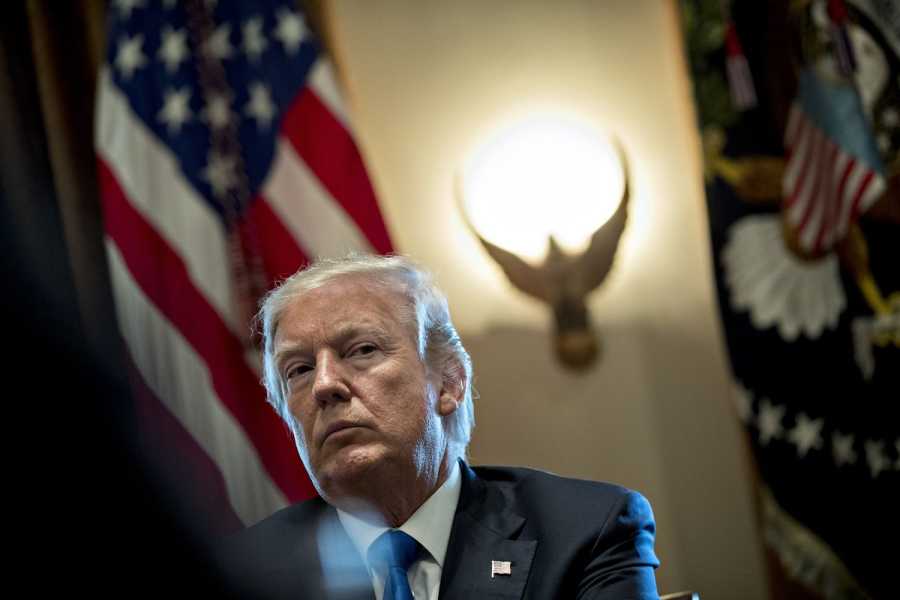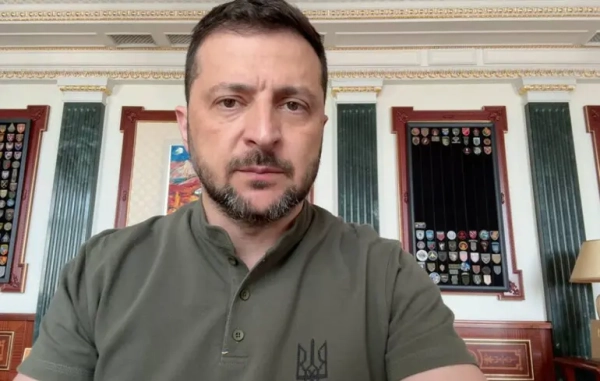They include harsh new proposals, and augmented versions of past ideas, too.

Trump’s immigration policies seek to build on those he implemented in his first term. Andrew Harrer/Bloomberg via Getty Images Li Zhou is a politics reporter at Vox, where she covers Congress and elections. Previously, she was a tech policy reporter at Politico and an editorial fellow at the Atlantic.
If you’re looking for a window into just how extreme another Donald Trump term could be — even compared to his first — the immigration policies he’s touted provide a clear preview.
Along with reupping his old ideas, Trump has spoken at length about how he intends to scale up his past policies, calling for the “largest domestic deportation operation in American history.” He’s focused, too, on bringing back wide-ranging raids to round up undocumented immigrants and setting up new camps where they’d be forcibly detained. And he’s interested in testing out proposals he didn’t get to last term, such as severely limiting birthright citizenship.
Essentially, Trump’s second-term immigration policy is shaping up to be much like his first, but even harsher.
Take Trump’s proposal for a new travel ban, a policy imposed during his first term: “When I return to office, [it’s] coming back even bigger than before and much stronger than before,” Trump said in a July 2023 speech.
That 2016 ban temporarily barred travelers from seven Muslim-majority countries from entering the US before it was struck down by the courts (only to return in updated form). On his first day in office, President Joe Biden rescinded the ban. This time around, Trump is weighing expanding this ban to encompass people from even more places, including Afghanistan and Gaza, and to bar those who express “communist” and “Marxist” views.
Much of what’s driving Trump’s hardline immigration policies is how they resonate with Republican base voters, including those who subscribe to xenophobic ideas of keeping migrants out and economic claims about immigrants purportedly taking jobs or abusing benefits. Additionally, a recent surge in migrant apprehensions across the southern border, as well as an influx of migrants in major cities across the country, has put the issue more prominently in the news, and provided a platform for Republicans — Trump included — to argue the current administration doesn’t have immigration under control.
Two developments could make Trump’s immigration policy in 2025 more viable than it was in his first term as well. Trump is reportedly planning to staff his next administration with loyalists who will find a way to execute his vision, unlike some of the staffers who’ve tried to restrain him in the past. And changes to the judiciary because of Trump’s appointments — including the stacking of the Supreme Court with his nominees — could mean a better legal reception for his policies. Biden has also added a high number of justices to the federal judiciary, but Trump’s nominees to the Supreme Court as well as powerful appeals panels like the Fifth Circuit have skewed key parts of the judiciary for the foreseeable future.
“2025 won’t feel like 2017,” Todd Schulte, the president of FWD.us, an immigration rights advocacy group that has fought Trump’s policies, told Vox. “2025 will feel radically different. And [people] should expect that when Donald Trump comes into office, families will be torn apart at the border and families will be torn apart in the United States.”
The Trump campaign did not respond to a request for comment about his plans. His advisers have made his ambitions clear, however. As Stephen Miller, one of Trump’s chief immigration advisers, put it in an interview with the New York Times: “Trump will unleash the vast arsenal of federal powers to implement the most spectacular migration crackdown.”
Trump’s immigration policies are now even more extreme
Trump and his advisers misleadingly claim that bringing back and augmenting past policies is necessary because a recent wave of immigrants is capitalizing on public services and allegedly sowing crime and disorder in different states and cities. Using rhetoric that echoes Nazis and authoritarians, Trump has made incendiary and racist statements about how immigrants are “poisoning the blood of our country” and coming to the US from “mental institutions,” all of which are discriminatory and unfounded.
Despite this, his calls for harsher policies have taken on a new tenor as places like New York City and Chicago have grappled with an influx of migrants in the last year, and as local leaders have called for more federal funding to assist them in providing resources like shelter.
Summarizing the GOP’s position in a statement to Vox, Lora Ries, the director of the Heritage Foundation’s Border Security and Immigration Center, argued: “The Biden Administration has erased our borders and the line between illegal and legal immigration.”
Implicit in this stance is that Trump’s policies would expand immigration restrictions and take on the issue in an even more punitive way. Below are some of the proposals that Trump’s team has laid out — and how they would work:
Mass deportations: A centerpiece of Trump’s immigration proposals is heavily inspired by a 1954 policy implemented by former President Dwight D. Eisenhower, who deported hundreds of thousands of undocumented Mexican workers during his administration.
As part of a program called “Operation Wetback,” which referenced a racist slur used to describe Mexican migrants, border control agents identified and detained undocumented people and forced them onto planes and trains to Mexico.
Trump has said he hopes to institute something similar, with the goal of completing annual deportations that number in the millions. That figure would be much higher than the number of deportations any recent administration — including Trump’s — has conducted.
As part of this effort, Trump’s team has said they’d like to capitalize on a policy known as “expedited removal,” which allows the government to rapidly remove undocumented people without a hearing.
Under most administrations (including the current one), this policy was only applied to people who had been in the US for 14 days or less, and who were within a 100-mile radius of the US border. In his first term, however, Trump expanded it — using it to deport anyone who couldn’t prove that they’d been in the US for more than two years.
Immigration experts have argued policies like this would amount to a nationwide “show me your papers” rule, and, as was the case with Eisenhower’s program, could also result in citizens and legal residents being mistakenly deported.
Raids: Miller tells the Times that there will be renewed attempts to conduct broad raids to detain undocumented immigrants that don’t focus on any specific individual, but that include large sweeps of workplaces and other public areas. Additionally, Trump’s campaign has said that he’ll seek to “deputize the National Guard and local law enforcement” to assist with these removals in jurisdictions that are open to supporting the effort.
Workplace raids were a feature of Trump’s first term, but they’ve since been ended by Biden.
Under Trump, the US saw the largest workplace raids in a decade, during which immigration officials targeted seven Mississippi poultry plants and apprehended 680 people. Trump’s raids also differed from those under his predecessor, because Obama’s immigration enforcement tended to prioritize people who were threats to national security, people with criminal convictions, and people who had been in the US for shorter amounts of time.
Obama was still nicknamed the “deporter-in-chief,” however, for how expansive his policies were. In comparison, Trump’s targeting was even more indiscriminate.
Any new raids are set to both build on the scope of past ones — and continue to expand their reach. Such policies have been criticized by immigration advocates, who note that these raids are traumatic and stressful, and that they often violate people’s due process rights.
Detention camps: Trump has expressed an interest in opening up detention camps where the US government can hold undocumented immigrants — both those apprehended at the border and inside the country — while their cases are being processed.
Presently, undocumented people don’t typically have to wait in a detention center while they await their trial, a period that could last months to years given how severe the immigration case backlog is. Trump would attempt to make detention a requirement while these cases are being considered.
The US doesn’t currently have sufficient space and facilities, let alone funding, to house the number of people who would be detained under Trump’s policy. To solve this problem, federal officials would build new camps, resembling existing ICE detention facilities, according to Miller.
Little is known about what such camps would ultimately include, but one possible example is a tent city that the Trump administration built for unaccompanied migrant children in Tornillo, Texas. That tent city — which was eventually shuttered — housed 2,000 minors and was criticized for failing to provide sufficient health care access.
UCLA immigration law professor Hiroshi Motomura noted that efforts to establish these camps would probably face legal challenges as well as potential public outcry. Such camps would infringe on immigrants’ civil rights and likely subject them to harsh living conditions.
“It’s going to remind people of Japanese American incarceration,” Motomura told Vox. “I think a big part of the American public would recoil at some of these things if they’re actually out there.”
Suspending refugee resettlement: Trump sharply cut the cap on refugees during his first term and he’s committed to suspending refugee resettlement if he retakes office.
That would mean another sharp drop in the number of refugees that the US takes in even as the number of displaced people around the world has grown.
The US has long been known as one of the most welcoming countries to refugees in the entire world, though the number of people who were accepted in Trump’s first term dropped 80 percent compared to that of his predecessor, undermining that perception.
Biden has increased the refugee cap to 125,000 people per year, a major uptick from the 15,000 people per year Trump had reduced it to in 2021. The Biden administration has also admitted tens of thousands of Ukrainian and Afghan refugees outside of this cap, and it’s unlikely Trump would continue these programs.
Such changes would leave tens of thousands of refugees fleeing war and poverty with limited recourse — and places to go.
Ending Temporary Protected Status programs: Under a program known as Temporary Protected Status, or TPS, people fleeing hardships in their country of origin are able to live and work in the US temporarily. (TPS, unlike refugee status, does not guarantee a legal pathway to citizenship, though it can be renewed.)
The Biden administration has extended the number of people who qualify for TPS, adding 400,000 Venezuelan migrants to the program.
Eliminating TPS is an effort Trump would resurrect, and that would likely go to the courts again. Were the administration actually successful in doing away with TPS, hundreds of thousands of people who’ve lived in the US for years could be forced to leave.
Making seeking asylum harder: Trump also intends to revive the “Remain in Mexico” policy, which requires people seeking asylum at the southern border to wait in Mexico while their claims are being processed. After the Supreme Court ruled that the Biden administration had the right to dismantle this program, it was shut down in 2022.
Additionally, Trump hopes to use the Title 42 policy — which allows presidents to temporarily throttle migration during public health emergencies — once more to bar migrants from entering the US on the grounds that they would be bringing in contagious illnesses. (That premise has previously been deemed false and refuted by public health experts.)
Immigration advocates have raised concerns that both programs increase the dangers migrants face after they’ve been expelled or while waiting in Mexico, including exposure to kidnapping and trafficking.
Ending DACA: Trump has made clear that he will again try to impose policies that the courts once opposed, including ending the Deferred Action for Childhood Arrivals program, which shields about 580,000 undocumented people who came to the US as children, from deportation.
In June 2020, the Supreme Court rejected the Trump administration’s attempts to sunset the program, which has faced additional court challenges since. Those challenges have led judges to bar new applicants from the program while allowing current recipients to continue receiving benefits.
If Trump were to successfully end DACA, it could be devastating for the thousands of people it covers and put them in a new state of legal limbo.
Reviving family separation hasn’t been ruled out: Trump has declined to rule out a potential resumption of family separations, a hardline “zero-tolerance” policy that was extremely controversial in his first term.
Under that policy, parents seeking asylum at the southern border were separated from their children and detained in separate facilities as they awaited legal proceedings. Thousands of children and parents were separated in this way, prompting widespread backlash and Trump to end the practice in 2018.
In 2021, the Biden administration officially rescinded the “zero-tolerance” policy that undergirded family separations. Were Trump to revive it, the effects could be traumatic and devastating for migrant families seeking asylum in the US.
Attacks on birthright citizenship: Currently, birthright citizenship is guaranteed by the 14th Amendment of the US Constitution.
Trump has said he’d announce a new executive order that bars the children of undocumented immigrants born in the US from obtaining birthright citizenship. This policy would almost certainly be immediately contested in court, and would probably be among the most difficult of Trump’s proposals to implement.
He’s said he wants to go after birthright citizenship because that would reduce the motivation for undocumented migrants to enter the US. According to the Migration Policy Institute, an immigration think tank that backs liberal proposals, this policy could increase the population of undocumented people by 4.7 million by 2050 given the number of children who have two unauthorized parents in the US.
Additionally, a move like this would undercut a longstanding tenet of the US immigration system, and the broader message it sends about who belongs in the US and who qualifies as a citizen.
A second Trump administration will have learned lessons from the first
Key differences could make a second Trump administration more effective at instituting these policies, too.
During his first administration, Trump was able to nominate three Supreme Court justices, tilting the court 6-3 in favor of conservative justices. He added a staggering number of judges to circuit courts and lower courts as well.
Additionally, the Supreme Court’s 2022 Aleman Gonzalez decision determined that lower courts couldn’t block certain national immigration policies from going into effect and that only the Supreme Court could do so. This means many major policy changes Trump could attempt would likely be decided by the Supreme Court — which, again, has an ideological bent in his favor.
As the Times reported, Trump is also intent on bringing on staffers and advisers who support his aims, unlike some who previously tried to curb him. There are also legal takeaways from his first term that Trump staffers would be able to apply if they try to resurrect contentious past proposals.
“Having attorneys who back his positions and who, through the course of his first term, developed the experience needed to write regulations that could withstand challenges in court — those would be important developments in terms of how effective he could be,” says Kathleen Bush-Joseph, a policy analyst at the Migration Policy Institute.
These factors could mean that Trump’s immigration policy might succeed where he once failed. They could suggest, too, that he’s able to build on what he achieved in his first term and magnify its impact even more.
“The tools that the president would have, were he to come back, to accomplish terrible aims are much, much, much worse and larger in 2025, than they were in 2017,” says Schulte.
Sourse: vox.com






